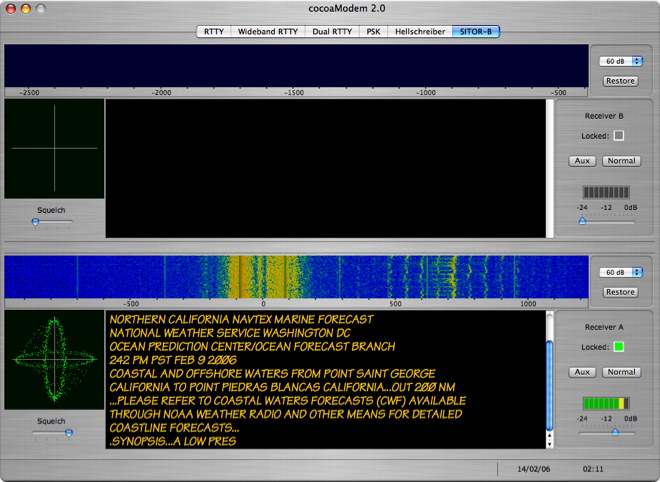
cocoaModem SITOR-B Receiver
Kok Chen, W7AY
[w7ay (at) arrl
(dot) net]
Last updated: Mar 29, 2006
Index (User's Manual - SITOR-B Receiver)
General Information
Aural Monitor
Accessibility (Incremental Speak and Voice Assist)
Macros
RTTY Interfaces
PSK Interface
MFSK Interface
Hellschreiber Interface
CW Interface
ASCII Interface
SITOR-B Receiver
- Hellschreiber Control Panel
- Receiver Section
- Transmitter Section
Synchronous AM Receiver
Versions
Part II
SITOR-B Receiver
cocoaModem supports a receive-only interface for the
SITOR-B protocol for reception of NAVTEX and W1AW AMTOR-FEC bulletins. There are
two independent receivers, each of which can be
connected to a different audio interface.
(International 518 kHz NAVTEX schedules can be found in
Annex 7 of this document. Details for USA station can
be found here.)
Fig 1 shows the SITOR-B interface (518 kHz NAVTEX broadcast
from Pt. Reyes, California):
SITOR-B is an implementation of CCIR 476-5 specifications,
using the same 170 Hz shift as Amateur RTTY, but at 100
baud and using synchronous transmission (no start or stop
bits). Character synchronization is from occasional sync
patterns and from the structure of the character stream
itself. FEC is achieved through the use of a 7-bit code,
which implements essentially the same character set as 5
bit Baudot, allowing single error bits per character to be
completely recoverable. In addition, each character is
repeated once in an interleaved character stream, delayed
from the original character by 35 bits. This repeated
character gives another layer for error detection and
correction.
In cocoaModem, SITOR-B squelch is not derived from the
signal strength for the FSK signal but from how may errors
need to be corrected. With maximal squelch (the squelch
slider pushed all the way towards the left), characters are
printed only the repeated and the original bytes are
identical and is zero Hamming distance away from a coded
character. The next level of squelch allows single error
bits to be corrected and printed if one of the characters
of the repeated pair has no error and is identical to the
corrected character. The next level allows both characters
to be correctable as long as the two corrected characters
are identical. The next squelch level allows printing if
either character is a single Hamming distance away from a
true encoding, etc.
The Locked indicator on the right shows the quality of the
received signal. When there is no decodable signal, the
locked indicator remains gray. The indicator turns yellow
when a synchronization sequence is received. It is
customary for a NAVTEX station to send many seconds of the
synchronization sequence when it first starts transmitting.
As long as the indicator remains solid yellow, you are
tuned to a good signal.
The indicator turns green when it is printing correctly. If
the print is not squelched, the indicator flashes orange
when any correctable error that is printed (with very high
probability of being correct). When printing error occurs,
the indicator will flash red. You will for example, not see
any red or orange flashes if the squelch control is pushed
all the way to the left since both correctable errors and
uncorrectable errors are squelched away.
The tuning mechanism is similar to the Wideband RTTY
Interface. You can use the default tone pairs, and tune the
transceiver itself so that the signal is lines up with the
green tone pair markers, or you can bring the signal within
the passband of the waterfall display and click on the mark
tone of the signal. The scroll wheel of a mouse can be used
to fine tune the signal when the cursor is within the
waterfall and the cocoaModem window is the active window.
The input device configuration is also similar to the other
modes (except there is no transmit section).
Next (HF-FAX)
